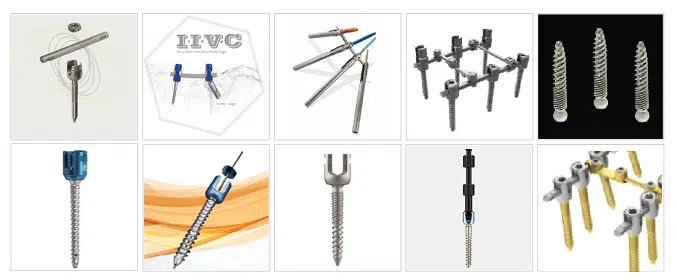In our latest article, we explored an emerging alternative to fenestrated screws. However, these screws remain the most widely used solution for achieving stable fixation in osteoporotic bone. Here’s a closer look at how they work, when to use them, and what to keep in mind.
As spinal surgeries increase, screw loosening—particularly in patients with poor bone quality due to osteoporosis or tumors—has become a major concern. This can compromise stability and increase the likelihood of revision surgery.
Among the available strategies, cement-augmented fenestrated screws stand out for their durability and performance. These implants have internal cannulas and lateral openings that allow for controlled injection of bone cement (typically PMMA), enhancing grip by interdigitating with the surrounding bone.
Why Use Fenestrated Screws?
- Enhanced Stability: Cement augmentation significantly increases resistance to pullout and loosening, especially in osteoporotic bone.
- Adaptability: The amount of cement can be adjusted to the patient’s anatomy and the clinical scenario.
- Versatility: Useful in osteoporosis, metastatic lesions, complex fractures, and revision surgeries.
- Reinforcement Synergy: They integrate well with vertebroplasty or kyphoplasty to provide comprehensive vertebral stabilization.
Potential Drawbacks
Despite their benefits, a few important considerations apply:
- Cement Leakage: The most frequent risk. While often asymptomatic, rare complications like nerve compression or embolism may occur.
- Technical Demands: Requires precise planning, fluoroscopic control, and familiarity with cement handling.
- Higher Cost: Both screws and surgical cement add to the overall procedure cost.
- Selective Indication: Not suitable for patients with good bone quality, where standard screws suffice.
When Are They Indicated?
- Severe osteoporosis requiring spinal fusion
- Vertebral collapse due to metastatic or primary tumors
- Revision surgeries for loosened hardware
- Unstable fractures needing additional support
Featured:

- ART®Fixation System (NG Medical)
- Intra Inter Vertebral Body Cage (LfC)
- MIS Z-Pedicle Screw System (Z-Medical GmbH)
- NORM SILVER Antibacterial Fenestrated Screw (NORMMED)
- AnyPlus® Fenestrated Screw System (GS Medical)
- Reborn ® Spinal Fixation System (BAUI)
- SmartLoc Omega (A-Spine)
- Ventotene Fenestrated Screws (Tsunami Medical)
- HPS™ 2.0 Hybrid Performance System (Paradigm Spine)
- 3D Titanium Pedicle Screws (Eminent Spine)
List of the relevant fenestrated-screws (alphabetic order): https://thespinemarketgroup.com/category/fenestrated-screws/
- Alpha FEN (GESCO)
- CREO® Fenestrated (Globus Medical)
- CarboClear® Fenestrated Pedicle Screws (CarboFix)
- Cypress (Safe Orthopedics)
- CD Horizon Solera Fenestrated Screws (Medtronic)
- DIPLOMAT® (SIGNUS)
- Ennovate® Thoracolumbar & Sacropelvic (BBraun Aesculap)
- JANUS Fenestrated Screws (Orthofix)
- Mantis Augmentable Spinal System (Stryker)
- Momentum® (Ulrich USA)
- MOSS FENESTRATED SCREW(Biedermann Motech)
- Osteobone (Auxein Medical)
- PEDIMAX II POROUS (GMReis)
- PROXiphias-F™ (PRODORTH)
- Reline Fenestrated (Nuvasive)
- Trend II – Bone Cement Screw (BIOMECH)
- uCentum® (Ulrich USA)
- VADER® MIS (Icotec)
- VERTICALE (Silony Medical)
- VENUS® Augmentation (HumanTech)
- VESTA Cement Injectable screw Spinal Fixation Syste (Osimplant)
- VIPER® Fenestrated Cortical Fix (Johnson&Johnson)
- WSI MX/PX-Titan Expertise Augmentable Screw (Peter Brehm)
We have updated this list including the Brochures, Surgical Techniques and Videos availble. We hope you find it useful and we appreciate and welcome any suggestions or comments.We may have missed some and we apologize for this.
All video parts, images and documents related to the products are of the sole property of the different companies.All the information is for Educational purpose only! No copyright infringement intended.We encourage you to contact us if you have any comment, suggestion or if you want us to include/remove your videos, images or brochures. Please contact us: spinemarketgroup@gmail.com
